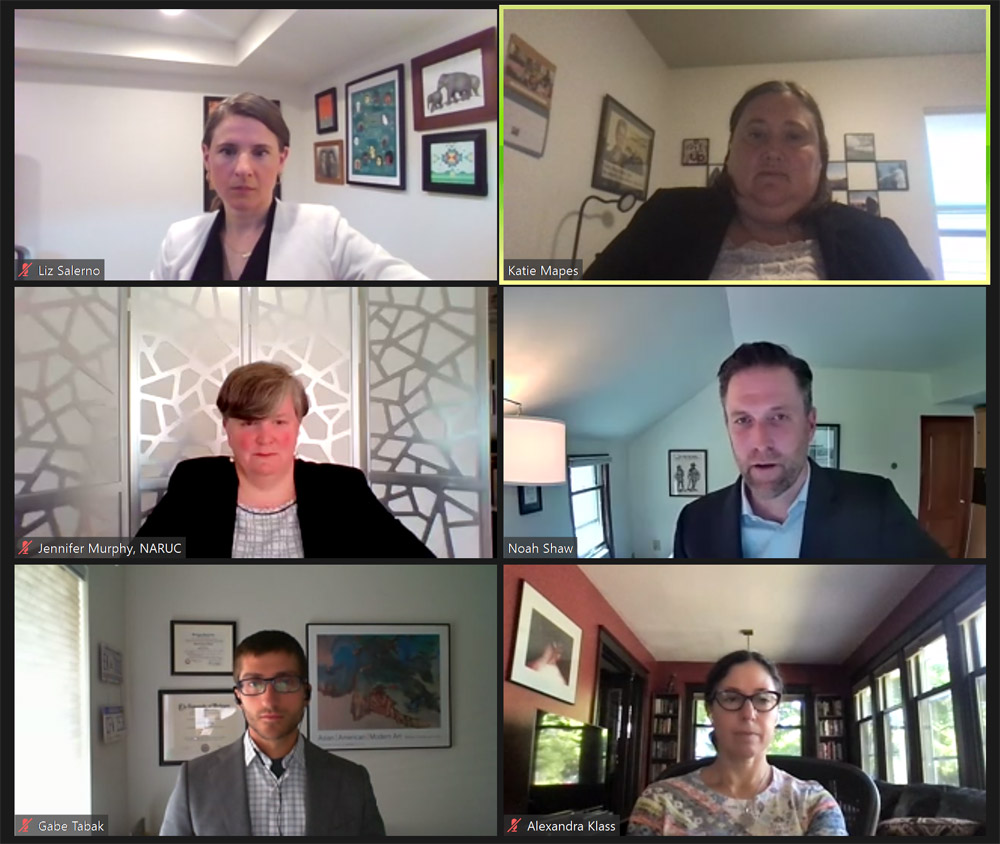Creating an equitable transmission grid for the United States will require not only thinking about the impact of new projects on low-income and disadvantaged “environmental justice” communities, but also recognizing “the equity implications of the status quo are pretty dire,” said Alexandra Klass, a professor at the University of Minnesota Law School.
“We know that the power grid wasn’t built to withstand today’s more frequent and intensive storms,” Klass said, speaking Friday on a virtual panel on the future of grid planning convened by the State Energy & Environmental Impact Center at NYU Law School. “So, when we delay building transmission, it means we have our old power grid that has greater environmental justice impacts every day … and we make the problem worse.”
Klass was one of four panelists who dissected FERC’s advanced notice of proposed rulemaking (ANOPR) on transmission planning and cost allocation, with a focus on what the commission’s 142-page document, released in July, may have left out and the challenges ahead. FERC is now about halfway through a 75-day comment period for the docket (RM21-17). (See FERC Goes Back to the Drawing Board on Tx Planning, Cost Allocation.)
Jennifer Murphy, senior counsel and director of energy policy at the National Association of Regulatory Utility Commissioners (NARUC), said her members believe “the planning process should require clear and standardized metrics for assessing the impacts on disadvantaged communities and ensuring that the benefits flow to those communities.
“We need to be specific and intentional,” she said, to ensure a new project doesn’t end up adding to negative impacts on disadvantaged communities.

“For finance providers, the risks that a system can’t deliver resources appropriately or includes significant upfront questions regarding deliverability, curtailment and interconnection costs and processing, [they] really end up getting rolled into the cost of the facility,” said Noah Shaw, a partner in the energy and climate practice at Foley Hoag LLC. “Understanding the capital providers’ perspective with respect to de-risking these projects should be paramount and important for purposes of policy making and cost considerations.”
State-level participation, beyond regulators, will also be important for breaking down traditional transmission planning silos that classify individual projects as meeting either economic, reliability or public policy needs, said Gabe Tabak, counsel for the American Clean Power Association.
“The goal here should be to really take the various state renewable energy goals and fully incorporate those into the transmission planning process really as a starting point,” Tabak said. “[We need] to assume that these are valid state goals that need to be met, that will be attained, and to look at what the least-cost means of getting to those state goals are, with a transmission plan that also addresses economic and reliability needs as well.”
Broad stakeholder engagement earlier in the process would also give state regulators time to “become more comfortable” with the complex issues involved in grid planning, Murphy said.
“It will allow them to know what the inputs are, what the assumptions being made are, where the data is coming from,” she said. “And if states are more comfortable with the inputs, they’re definitely going to be more comfortable with the outcomes.”
‘Super Technical and Nerdy’
Friday’s webinar reflected the intensifying focus on the role of transmission in President Biden’s goal to decarbonize the nation’s electricity system by 2035 and move toward a net-zero economy by 2050. The bipartisan infrastructure bill now in Congress would provide $73 billion for transmission projects, and advocates are pushing for a transmission investment tax credit in the $3.5 trillion budget reconciliation package, also still moving through Congress.
But, as many in the industry have noted, transmission projects often stall out because of the long permitting and planning processes they must go through. The problems are “super technical and nerdy,” said Shaw. “But for all those people who care about climate change, it’s the biggest thing we’re going to have to deal with in the electricity system over the course of the next five years.”

Salerno provided an overview of the background and main points of the ANOPR, specifically its goal to overhaul Rule 1000 ― the transmission planning framework FERC issued 10 years ago ― in the face of the dramatic changes in generation resources and the demands variable, renewable energy is placing on the grid.
“The existing transmission planning process as required under our current rules just may not sufficiently do enough forward-looking and proactive planning for the future,” Salerno said. “Because of that, the way we’re planning for future generation, almost by default, is done on a project-by-project basis.”
With 750 GW of mostly renewable projects sitting on interconnection queues across the country, “projects move through the queue … upgrades get identified, costs get assigned and then either the project moves forward, or it doesn’t,” she said. “That sort of step-by-step approach maybe isn’t a particularly cost-effective or efficient way to build up the grid.”
In addition, it “could be leading to a result that’s ultimately more expensive for ratepayers than an approach that’s more forward-looking and proactive,” she said.
Salerno’s comments largely echoed the arguments that Glick and Commissioner Allison Clements set out in a joint statement in support of the ANOPR.
Acknowledging the need for new ideas, the ANOPR solicits input on several questions:
-
-
- how to accommodate anticipated future generation within the regional transmission planning and cost allocation processes;
- whether the commission should require transmission providers to identify geographic zones with the potential for developing large amounts of renewables and plan transmission to integrate those resources;
- whether changes are needed to improve the coordination between the regional transmission planning and cost allocation and generator interconnection processes;
- how to allocate the costs of new transmission in a way that allocates costs “at least roughly commensurate” with estimated benefits; and
- whether participant funding of interconnection-related network upgrades may be unjust and unreasonable and whether FERC should eliminate rules that allow RTOs/ISOs to use participant funding for interconnection-related network upgrades.
-
The Regulatory Mismatch
Murphy said NARUC supports a more “holistic” approach to transmission planning, as opposed to Rule 1000’s siloing of projects based on their impact on economic, reliability or public policy considerations.
“A holistic approach would look at the impact of siloing on planning, cost allocation and whether better outcomes could be achieved if needs were not divided in this way,” she said. It would “also consider alternative transmission solutions, including grid-enhancing technologies and non-transmission technologies in the regional planning process,” she said. (See FERC Workshop Participants Differ on GETs Incentives.)
But Klass saw a larger challenge for any effort to reform transmission planning and cost allocation.
“The physical aspects of how the U.S. electric grid has worked for decades don’t match the regulatory authority for the new lines we need for a grid that’s powered primarily on renewable energy and is reliable and resilient in an age of climate change,” she said. “In terms of building the grid of the future with interstate, long-distance transmission lines designed to ship renewable power across the country, we have a regulatory regime where states and in some cases counties within states hold virtually all the regulatory power. And without a major shift in that regulatory authority, progress is going to be slow.”
One solution, Klass said, could be financial incentives that “can both flow up to the companies that are able to take on these significant projects, and also flow down to the level in which regulatory authority exists so that money can be spread to all of the impacted communities that are going to need to be convinced that these projects are in their interest.”
Another challenge will be integrating the impact of extreme weather events into planning processes, Shaw said. The ANOPR doesn’t specifically talk about weather, he said. Long-term generation and transmission planning must take into consideration the impacts of such events and “the locational value of the resources that are being proposed in any particular transaction,” Shaw said.
How to value projects that provide system reliability and resilience will also require considering the impact of not making those investments, he said. “There’s an opportunity cost to not planning longer term.”




